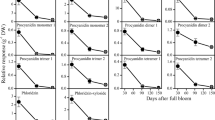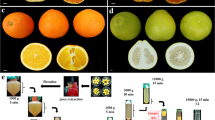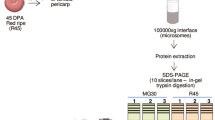Abstract
MANY fruits, including the avocado, exhibit a marked increase in respiration during the ripening process which is known as the ‘climacteric rise’1. An explanation of this phenomenon has been sought by investigating the oxidation and phosphorylation of cytoplasmic particles isolated from fruit at various points during the post-harvest life of the fruit. Particles have been isolated from avocados2, apples3, tomatoes4, bananas5 and papayas6 which proved capable of oxidizing Krebs cycle acids. Only in the case of avocado fruit at the climacteric peak2 has it been shown conclusively that the particles were able to exhibit the phenomenon of ‘respiratory control’7. This communication describes modifications to a method given by Wiskich et al.2 by which particles that show respiratory control and coupled phosphorylation may be isolated from avocado fruit at all stages of ripeness. The revised method has also been successfully applied to sweet potatoes and tomato fruit.
This is a preview of subscription content, access via your institution
Access options
Subscribe to this journal
Receive 51 print issues and online access
$199.00 per year
only $3.90 per issue
Buy this article
- Purchase on Springer Link
- Instant access to full article PDF
Prices may be subject to local taxes which are calculated during checkout
Similar content being viewed by others
References
Biale, J. B., Handbuch der Pflanzenphysiologie, 12, part 2, 536 (1960).
Wiskich, J. T., Young, R. E., and Biale, J. B., Plant Physiol., 39, 312 (1964).
Jones, J. D., Hulme, A. C., and Wooltorton, L. S. C., Phytochem., 3, 201 (1964).
Dickinson, D. B., and Hanson, J. B., Plant Physiol., 40, 161 (1965).
Tager, J. M., S. African J. Sci., 54, 324 (1958).
Tager, J. M., Plant Physiol. Res. Inst., Univ. Pretoria, Ann. Rep. for 1958, p. 78 (1958).
Chance, B., and Williams, G. R., J. Biol. Chem., 217, 383 (1955).
Young, R. E., and Biale, J. B., Plant Physiol., 37, 409 (1962).
Author information
Authors and Affiliations
Rights and permissions
About this article
Cite this article
HOBSON, G., LANCE, C., YOUNG, R. et al. Isolation of Active Subcellular Particles from Avocado Fruit at Various Stages of Ripeness. Nature 209, 1242–1243 (1966). https://doi.org/10.1038/2091242a0
Issue Date:
DOI: https://doi.org/10.1038/2091242a0
This article is cited by
-
Isolierung und Eigenschaften von Mitochondrien aus Bl�ttern von Spinacia oleracea und Beta vulgaris
Planta (1971)
-
Metabolism at several levels of organization in the fruit of the avocado, Persea americana, Mill.
Qualitas Plantarum et Materiae Vegetabiles (1969)
-
Respiratory Control by Isolated Apple Mitochondria
Nature (1966)
Comments
By submitting a comment you agree to abide by our Terms and Community Guidelines. If you find something abusive or that does not comply with our terms or guidelines please flag it as inappropriate.



